Echo sounding, also known as radio-echo sounding (RES), is a powerful technique that uses radio waves to explore what lies beneath ice sheets and glaciers, and at streetsounds.net, we are passionate about exploring the depths of sound, both literal and metaphorical. It’s like giving the Earth an ultrasound, allowing scientists to map hidden landscapes and understand ice behavior. This technology provides crucial data for climate models and offers insights into the Earth’s past.
1. What Is Echo Sounding, and Why Is It Important?
Echo sounding, or radio-echo sounding (RES), is a method that uses radio waves to investigate subsurface features, particularly in ice sheets and glaciers. This technology is invaluable because it allows scientists to measure ice thickness, map bed topography, and study subglacial hydrology, all of which are critical for understanding ice sheet dynamics and predicting sea-level rise.
1.1. Understanding the Fundamentals of Radio-Echo Sounding
Radio-echo sounding (RES) operates on the principle of sending radio waves into the ice and analyzing the returning echoes. The time it takes for these waves to bounce back reveals the depth and characteristics of the layers beneath the ice. This is crucial for understanding ice volume and shape, particularly in areas where ice covers the land. According to research from the University of Newcastle’s geography department, in July 2024, RES is the most effective method for imaging the bed beneath ice sheets, uncovering details about the rock, water, and sediment that lie below.
1.2. The Significance of Ice Thickness Measurement
Measuring ice thickness is essential for understanding the dynamics of glaciers and ice sheets. RES accurately determines the thickness of the ice, providing vital data for climate models that project sea-level rise. This measurement helps scientists create detailed maps of the underlying terrain, revealing complex networks of subglacial valleys and mountains hidden from view.
1.3. Mapping Bed Topography Underneath Glaciers
Bed topography, or the shape of the land beneath the ice, significantly influences how glaciers flow and respond to climate change. RES allows scientists to map this topography in detail, revealing features like the Gamburtsev Mountains in East Antarctica. According to a study published in Geophysical Research Letters, detailed mapping of bed topography enables more accurate modeling of ice sheet behavior and stability.
1.4. Investigating Subglacial Hydrology with Echo Sounding
Subglacial hydrology, the study of water beneath glaciers, is critical for understanding ice dynamics and mass balance. RES can detect subglacial lakes and water networks, providing insights into how water flow affects ice movement and the supply of water to the oceans. Research in Nature Reviews Earth & Environment indicates that understanding subglacial water systems is essential for predicting how ice sheets will respond to warming climates.
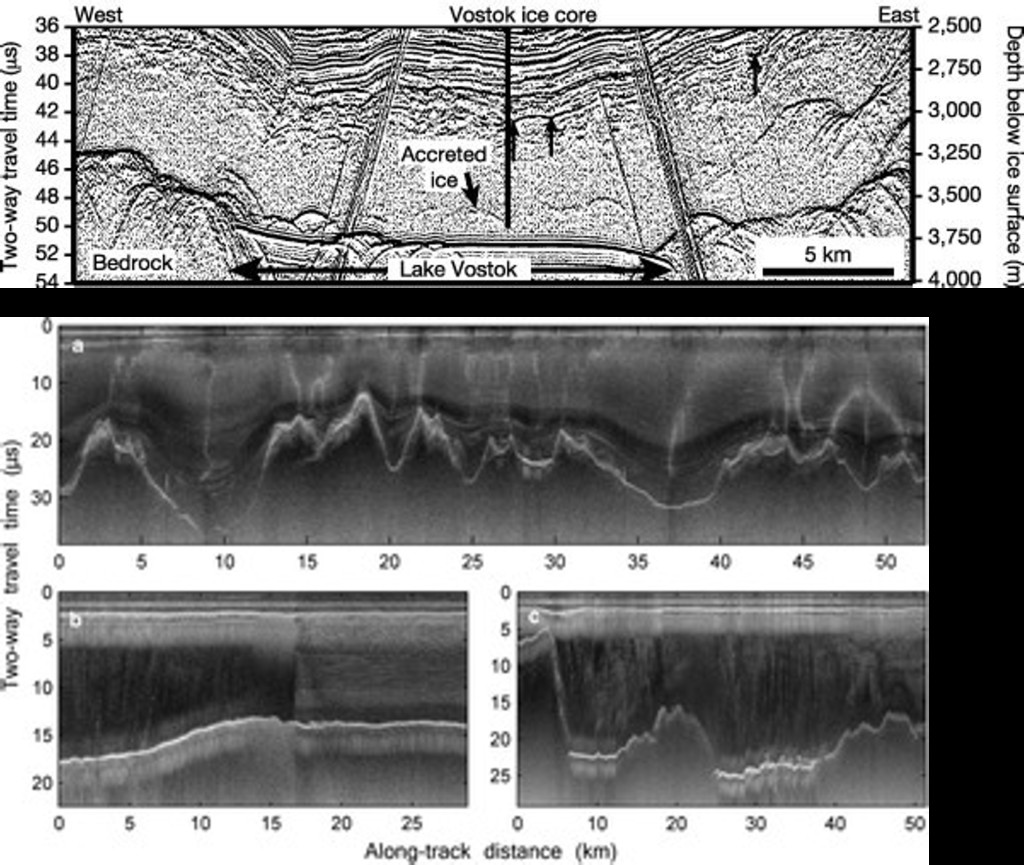 Airborne ice-penetrating radar data showing subglacial lakes: Lake Vostok is visible as a bright flat reflector
Airborne ice-penetrating radar data showing subglacial lakes: Lake Vostok is visible as a bright flat reflector
1.5. Applications in Planetary Science
Beyond Earth, RES is used in planetary science to explore the subsurface of polar ice caps on Mars and comets. This application extends our understanding of glacial processes to other celestial bodies, offering insights into their geological history and potential for past or present water. According to Science, radar soundings on Mars have revealed subsurface features that suggest past glacial activity.
2. How Does Echo Sounding Technology Work?
Echo sounding technology operates by emitting electromagnetic waves into the ice and recording the reflections that return from various features. The system measures the time it takes for these waves to travel through the ice and bounce back, which is used to determine the depth and characteristics of the subsurface layers.
2.1. The Process of Emitting Electromagnetic Waves
The process begins with an RES system emitting electromagnetic waves into the ice. These waves are typically in the radio frequency range, allowing them to penetrate deeply into the ice. The frequency and power of the signal are carefully controlled to optimize penetration and reflection.
2.2. Recording Reflections from Subsurface Features
As the electromagnetic waves travel through the ice, they encounter changes in density and composition, such as internal layers, the ice bed, or liquid water. These changes cause the waves to reflect back towards the surface. The RES system records these reflections, capturing information about their strength and arrival time.
2.3. Determining Depth and Characteristics of Subsurface Layers
The time it takes for the reflected waves to return is used to calculate the depth of the reflecting layer. By analyzing the strength and characteristics of the reflected signals, scientists can infer properties such as the density, composition, and structure of the subsurface layers. This data is then used to create detailed profiles and maps of the ice and the features beneath it.
2.4. Variations in Radio Echo Sounding Measurements
RES measurements can vary based on several factors, including the type of platform used (airborne or ground-based), the speed of the platform, the central frequency of the radar, and the design of the system (pulsed, chirp pulse, or continuous waveform). Each variation is suited to different research objectives and environments.
2.5. Signal Processing Techniques for Improved Image Quality
The raw data collected by RES systems often undergoes significant signal processing to remove clutter and improve image quality. These techniques enhance the clarity of the reflections, making it easier to identify and analyze subsurface features. The processed data provides a clearer picture of the ice structure and bed topography, enabling more accurate scientific interpretations.
3. What Can Echo Sounding Reveal About Ice Sheets?
Echo sounding provides a wealth of information about ice sheets, including their thickness, internal layers, and the characteristics of the bed beneath the ice. This data is essential for understanding ice sheet dynamics, past behavior, and future changes.
3.1. Unveiling Ice Thickness and Bed Topography
RES is a primary method for mapping ice thickness and bed topography. By sending radio waves through the ice and measuring the time it takes for them to reflect off the bed, scientists can create detailed maps of the underlying terrain. These maps reveal complex networks of subglacial valleys and mountains, providing crucial context for understanding ice flow. According to the Scientific Committee on Antarctic Research (SCAR), detailed bed topography maps are vital for improving ice sheet models.
3.2. Discovering Subglacial Lakes and Water Networks
RES has been instrumental in detecting subglacial lakes and water networks beneath ice sheets. The strong, smooth basal reflections imaged by RES indicate the presence of liquid water. This information is crucial for understanding subglacial hydrology and its impact on ice dynamics. Research in Nature Reviews Earth & Environment highlights the importance of subglacial water systems in regulating ice sheet behavior.
3.3. Studying Internal Layers and Ice Sheet History
RES can reveal internal layers within ice sheets, providing insights into past ice temperature, density, and accumulation rates. Analyzing these layers allows scientists to observe changes in ice flow over time. For example, internal layer analysis in Greenland has provided valuable information about the ice sheet’s history and dynamics, as noted in the Journal of Geophysical Research: Earth Surface.
3.4. Connecting Internal Layers with Ice Core Data
Work is increasingly being done to connect internal layers identified by RES with data from ice cores. This correlation allows scientists to extend the climate record provided by ice cores across a larger area of the ice sheet. By tracing continuous internal layers, researchers can unveil the age-depth relationship of the ice, as highlighted in Science.
3.5. Identifying Changes in Ice Flow and Dynamics
By analyzing the structure and orientation of internal layers, scientists can identify changes in ice flow and dynamics. This information is crucial for understanding how ice sheets respond to climate change and for predicting future ice loss. The British Antarctic Survey’s aerogeophysical data provides valuable resources for studying these changes.
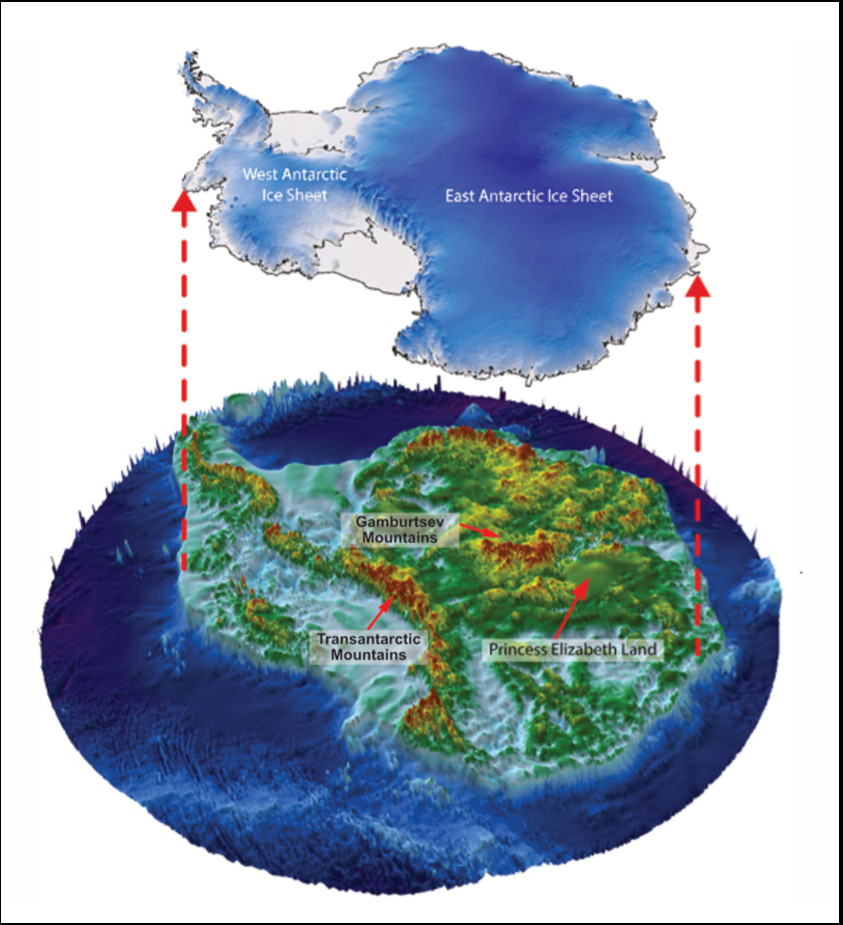 Bed topography of Antarctica and the Gamburtsev Mountains
Bed topography of Antarctica and the Gamburtsev Mountains
4. What Are the Applications of Echo Sounding in Different Fields?
Echo sounding has diverse applications across various fields, from glaciology and climate science to planetary exploration. Its ability to provide detailed subsurface information makes it an invaluable tool for research and monitoring.
4.1. Applications in Glaciology
In glaciology, RES is used to measure ice thickness, map bed topography, study subglacial hydrology, and analyze internal layers within ice sheets. These applications help scientists understand ice dynamics, mass balance, and the impact of climate change on glaciers and ice sheets.
4.2. Use in Climate Science
Climate scientists rely on RES data to improve ice sheet models and project future sea-level rise. The detailed information on ice thickness, bed topography, and subglacial water systems helps refine these models, leading to more accurate predictions. According to research from the University of Newcastle, RES-derived data is crucial for understanding the complex interactions within ice sheets and their response to warming climates.
4.3. Application in Planetary Exploration
RES is used in planetary exploration to study the subsurface of ice caps on Mars and other celestial bodies. This application provides insights into the geological history and potential for water on these planets. Radar soundings on Mars, for example, have revealed subsurface features indicative of past glacial activity, as reported in Science.
4.4. Investigating Subsurface of Polar Ice Caps
RES helps in investigating the subsurface of polar ice caps, revealing information about ice thickness, internal layers, and the presence of water. This data is essential for understanding the dynamics and evolution of these ice caps. The Center for Remote Sensing and Integrated Systems (CReSIS) provides access to data products for studying polar ice caps.
4.5. Monitoring Environmental Changes
By repeatedly surveying ice sheets and glaciers with RES, scientists can monitor changes in ice thickness, bed topography, and subglacial water systems over time. This monitoring helps track the impact of climate change and assess the stability of ice sheets. The British Antarctic Survey’s Polar Airborne Geophysics Data Portal offers data for monitoring environmental changes in Antarctica.
5. How Is Echo Sounding Data Collected and Processed?
Collecting and processing echo sounding data involves several steps, from initial data acquisition to advanced signal processing techniques. These steps ensure that the data is accurate, reliable, and useful for scientific analysis.
5.1. Airborne and Ground-Based Data Acquisition Techniques
RES data can be acquired using both airborne and ground-based techniques. Airborne surveys involve mounting radar systems on aircraft, allowing for rapid coverage of large areas. Ground-based surveys, on the other hand, involve deploying radar systems on the ground, providing more detailed measurements in specific locations.
5.2. Factors Affecting Data Quality
Several factors can affect the quality of RES data, including the frequency and power of the radar signal, the ice temperature and density, and the presence of liquid water or debris within the ice. Careful system design and calibration are essential for obtaining accurate and reliable results.
5.3. Signal Processing Techniques for Clutter Removal
Collected radar data typically undergoes signal processing to remove clutter and improve image quality. These techniques enhance the clarity of the reflections, making it easier to identify and analyze subsurface features. Common signal processing methods include filtering, deconvolution, and migration.
5.4. Creating Maps of Bed Topography and Ice Thickness
The processed RES data is used to create detailed maps of bed topography and ice thickness. These maps are generated by interpolating the radar measurements and combining them with other data sources, such as satellite imagery and digital elevation models. The resulting maps provide a comprehensive view of the ice sheet and the terrain beneath it.
5.5. Ensuring Data Accessibility and Reusability
Efforts are underway to ensure that RES data is findable, accessible, interoperable, and reusable (FAIR). Initiatives such as the British Antarctic Survey’s Polar Airborne Geophysics Data Portal and the Center for Remote Sensing and Integrated Systems data products provide access to data across Antarctica and Greenland, promoting collaboration and advancing scientific research.
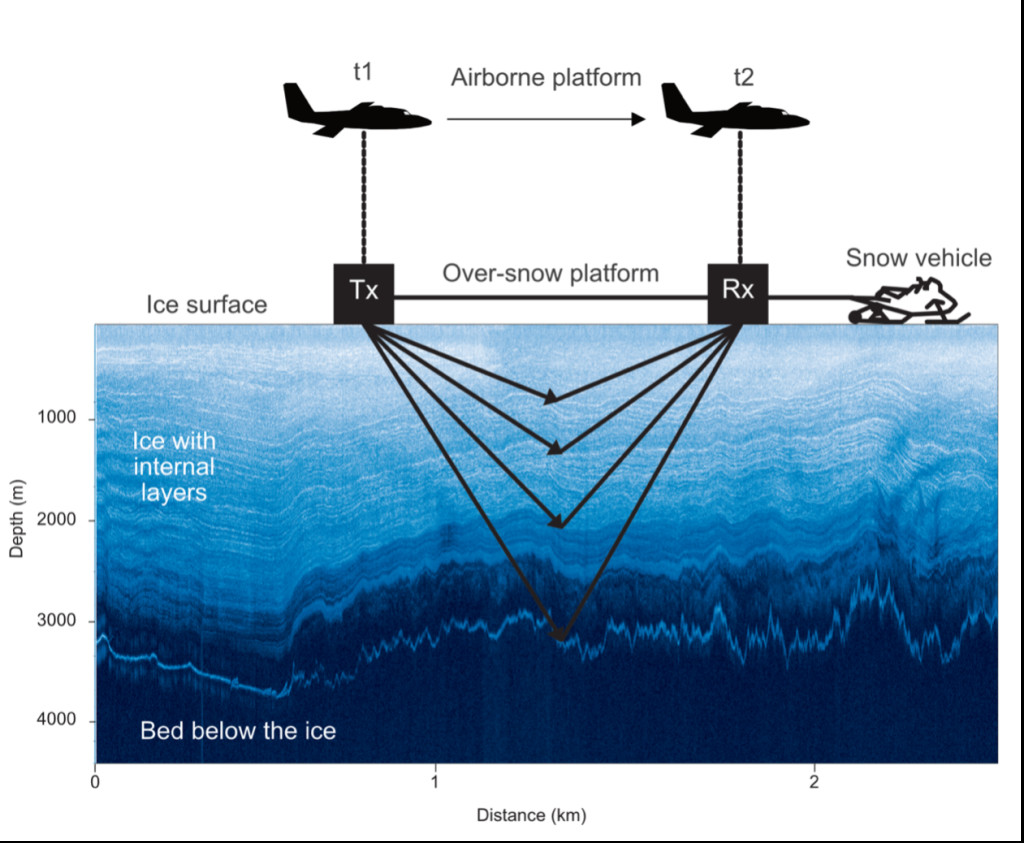 Ice penetrating radar collection techniques: The radar shows the complex bed topography beneath the ice and examples of bright internal layer reflections.
Ice penetrating radar collection techniques: The radar shows the complex bed topography beneath the ice and examples of bright internal layer reflections.
6. What Are the Challenges and Limitations of Echo Sounding?
While echo sounding is a powerful tool, it also has several challenges and limitations that can affect the accuracy and reliability of the data. Understanding these limitations is crucial for interpreting RES results and planning future research.
6.1. Issues with Data Accuracy and Resolution
One of the main challenges of RES is ensuring data accuracy and resolution. Factors such as ice temperature, density variations, and the presence of liquid water can affect the propagation of radio waves and introduce errors in depth measurements. Careful system calibration and advanced signal processing techniques are needed to minimize these errors.
6.2. The Impact of Ice Temperature and Density
Ice temperature and density significantly influence the penetration and reflection of radio waves. Warmer ice and areas with high density variations can attenuate the radar signal, reducing the depth of penetration and the quality of the data.
6.3. Challenges Posed by Liquid Water and Debris
The presence of liquid water and debris within the ice can also pose challenges for RES. Liquid water can absorb radio waves, reducing the signal strength and making it difficult to image deeper layers. Debris can scatter radio waves, creating clutter and reducing the clarity of the data.
6.4. Limitations in Penetration Depth
RES has limitations in penetration depth, particularly in areas with thick ice or high signal attenuation. The maximum penetration depth depends on the frequency and power of the radar signal, as well as the properties of the ice. In some cases, it may not be possible to image the bed beneath the ice sheet.
6.5. The Need for Advanced Signal Processing Techniques
Overcoming the challenges and limitations of RES requires advanced signal processing techniques. These techniques help remove clutter, correct for signal attenuation, and improve the resolution of the data. Continued development of these techniques is essential for maximizing the potential of RES.
7. How Is Echo Sounding Contributing to Climate Change Research?
Echo sounding plays a crucial role in climate change research by providing essential data for ice sheet models, monitoring ice sheet stability, and understanding the impact of warming climates on glaciers and ice sheets.
7.1. Providing Data for Ice Sheet Models
RES provides critical data for ice sheet models, which are used to project future sea-level rise. The accurate measurements of ice thickness, bed topography, and subglacial water systems help refine these models, leading to more reliable predictions. According to the Intergovernmental Panel on Climate Change (IPCC), improved ice sheet models are essential for understanding the potential impacts of climate change.
7.2. Monitoring Ice Sheet Stability
By repeatedly surveying ice sheets with RES, scientists can monitor changes in ice thickness, bed topography, and subglacial water systems over time. This monitoring helps track the stability of ice sheets and assess the impact of climate change. The British Antarctic Survey’s Polar Airborne Geophysics Data Portal offers data for monitoring environmental changes in Antarctica.
7.3. Understanding the Impact of Warming Climates
RES helps in understanding the impact of warming climates on glaciers and ice sheets. The data provides insights into how ice sheets respond to rising temperatures, changes in precipitation patterns, and other climate-related factors. Research in Nature Reviews Earth & Environment highlights the importance of understanding these responses for predicting future sea-level rise.
7.4. Assessing Subglacial Lake Dynamics
RES has been instrumental in assessing subglacial lake dynamics and their role in ice sheet behavior. The data provides information about the size, shape, and water volume of subglacial lakes, as well as their connections to subglacial drainage systems. Understanding these dynamics is crucial for predicting how ice sheets will respond to warming climates.
7.5. Predicting Future Sea-Level Rise Scenarios
By providing essential data for ice sheet models and monitoring ice sheet stability, RES contributes to predicting future sea-level rise scenarios. These predictions are crucial for informing policy decisions and preparing for the potential impacts of climate change. The IPCC relies on RES data to assess the potential range of sea-level rise scenarios.
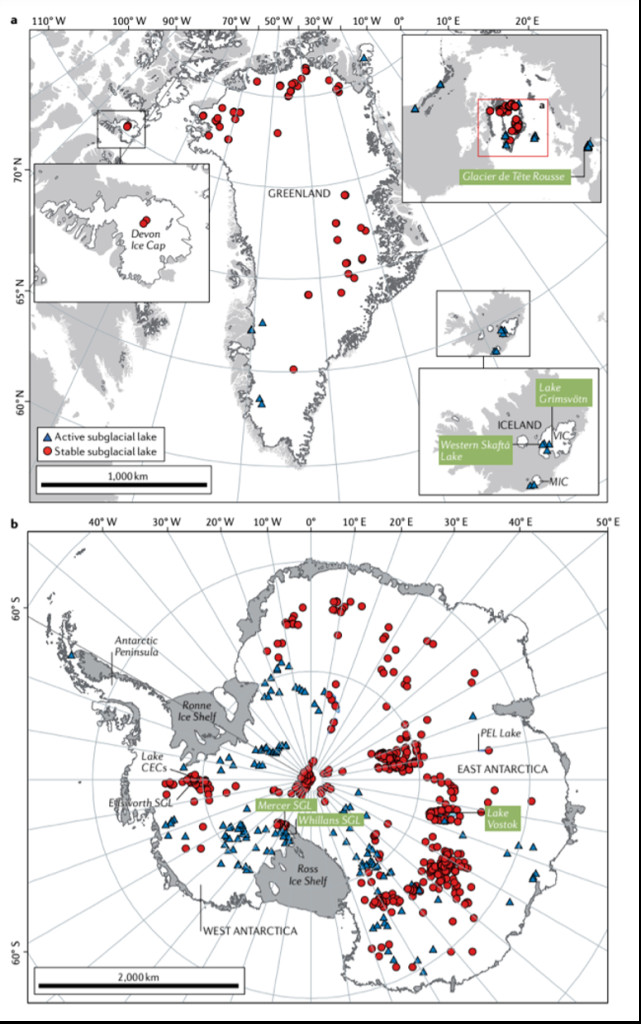 Global inventory of subglacial lakes
Global inventory of subglacial lakes
8. What Innovations Are Improving Echo Sounding Technology?
Several innovations are improving echo sounding technology, enhancing its accuracy, resolution, and versatility. These advancements are enabling scientists to study ice sheets and glaciers in greater detail and address new research questions.
8.1. Advancements in Radar System Design
Advancements in radar system design are leading to more powerful and efficient RES systems. These systems incorporate new technologies such as synthetic aperture radar (SAR) and advanced signal processing algorithms, which improve the resolution and accuracy of the data.
8.2. Improved Signal Processing Algorithms
Improved signal processing algorithms are enhancing the quality of RES data by removing clutter, correcting for signal attenuation, and improving the resolution of subsurface features. These algorithms are essential for extracting meaningful information from the radar signals.
8.3. Development of Autonomous Survey Platforms
The development of autonomous survey platforms, such as drones and robotic vehicles, is enabling RES data collection in remote and challenging environments. These platforms can be equipped with radar systems and programmed to autonomously survey ice sheets and glaciers, providing valuable data in areas that are difficult to access.
8.4. Integrating RES with Other Geophysical Techniques
Integrating RES with other geophysical techniques, such as seismic surveys and gravity measurements, provides a more comprehensive view of ice sheets and the underlying terrain. This integration allows scientists to combine different types of data to create more detailed and accurate models of ice sheet behavior.
8.5. Enhancing Data Accessibility and Collaboration
Efforts are underway to enhance data accessibility and collaboration by creating open-source data repositories and promoting data sharing among researchers. These initiatives facilitate the use of RES data in a wider range of studies and accelerate scientific progress.
9. What Are Some Notable Discoveries Made with Echo Sounding?
Echo sounding has led to numerous notable discoveries, transforming our understanding of ice sheets, subglacial environments, and the dynamics of polar regions.
9.1. Mapping the Gamburtsev Mountains in Antarctica
RES revealed the Gamburtsev Mountains, a range similar in size to the Alps, buried beneath 2-3 km of ice in East Antarctica. This discovery transformed our understanding of the region’s geological history and its influence on ice sheet dynamics. According to EOS, the Gamburtsev Mountains play a significant role in shaping the flow of ice in East Antarctica.
9.2. Discovering Subglacial Lakes Beneath Ice Sheets
RES has been instrumental in discovering hundreds of subglacial lakes beneath ice sheets, including Lake Vostok, one of the largest known subglacial lakes in Antarctica. These discoveries have revolutionized our understanding of subglacial hydrology and its impact on ice sheet behavior.
9.3. Unveiling Ancient Landscapes and River Systems
RES has unveiled ancient landscapes and river systems buried beneath ice sheets, providing insights into past climate conditions and the evolution of polar regions. These discoveries have helped scientists reconstruct the history of ice sheets and their response to climate change.
9.4. Identifying Changes in Ice Flow and Dynamics
By analyzing internal layers and bed topography, RES has identified changes in ice flow and dynamics over time, providing valuable information about the response of ice sheets to climate change. These findings have helped refine ice sheet models and improve predictions of future sea-level rise.
9.5. Exploring the Subsurface of Polar Ice Caps on Mars
RES has been used to explore the subsurface of polar ice caps on Mars, revealing evidence of past glacial activity and potential water reservoirs. These discoveries have expanded our understanding of the planet’s geological history and its potential for supporting life.
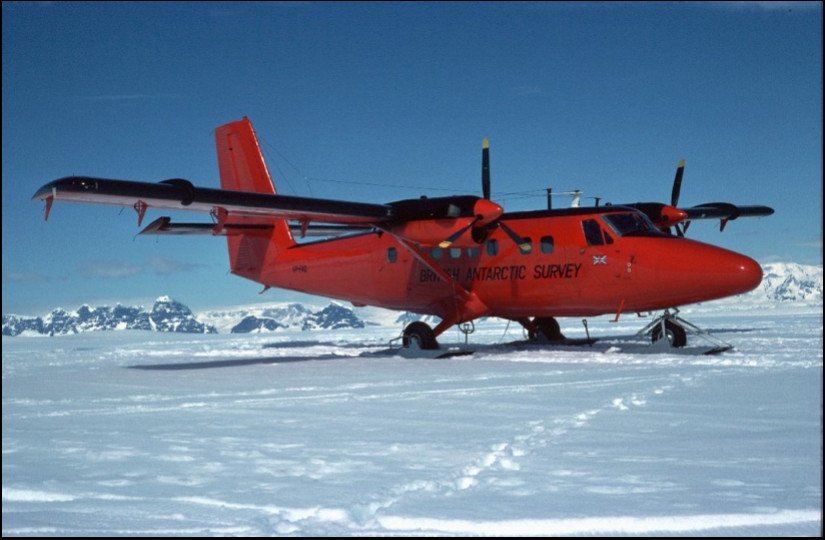 Twin Otter Aircraft- British Antarctic Survey
Twin Otter Aircraft- British Antarctic Survey
10. How Can You Explore Street Sounds and Urban Soundscapes?
While echo sounding explores the depths of ice sheets, streetsounds.net invites you to explore the depths of urban soundscapes. Discover how you can capture, create, and connect with the vibrant sounds of the streets.
10.1. Discovering Unique Sound Effects at streetsounds.net
At streetsounds.net, you can explore a diverse library of high-quality street sound effects. From bustling city ambiences to unique urban noises, find the perfect sounds to enhance your creative projects.
10.2. Enhancing Music and Art with Urban Audio
Enhance your music and art with authentic urban audio. Streetsounds.net provides the resources and inspiration to incorporate street sounds into your compositions, adding depth and realism to your creative work.
10.3. Capturing Authentic Urban Soundscapes
Learn techniques for capturing authentic urban soundscapes. Streetsounds.net offers guides and tips for recording high-quality audio in urban environments, helping you create immersive and realistic soundscapes.
10.4. Sharing and Connecting with the streetsounds.net Community
Join the streetsounds.net community to share your recordings, collaborate on projects, and connect with other sound enthusiasts. Share your passion for urban sounds and explore new creative possibilities together.
10.5. Creating Immersive Soundscapes for Film and Games
Create immersive soundscapes for film and games with streetsounds.net. Access a wide range of urban sound effects and learn how to create realistic audio environments that enhance the viewer’s experience.
Ready to delve into the world of urban soundscapes? Visit streetsounds.net today to explore our extensive library, connect with fellow sound enthusiasts, and start creating your own unique sonic experiences. Whether you’re a musician, filmmaker, game designer, or simply a lover of sound, streetsounds.net offers everything you need to capture, create, and connect with the vibrant sounds of the streets. Don’t miss out on the opportunity to enhance your projects with the authentic and captivating sounds of urban life. Join us now and unleash your sonic creativity!
Address: 726 Broadway, New York, NY 10003, United States
Phone: +1 (212) 998-8550
Website: streetsounds.net
FAQ: Everything You Need to Know About Echo Sounding
Q1: What is echo sounding, and how does it work?
Echo sounding, or radio-echo sounding (RES), is a technique that uses radio waves to explore subsurface features, particularly in ice sheets and glaciers. It works by emitting radio waves into the ice and analyzing the returning echoes to measure ice thickness, map bed topography, and study subglacial hydrology.
Q2: Why is echo sounding important for climate change research?
Echo sounding provides essential data for ice sheet models, monitors ice sheet stability, and helps understand the impact of warming climates on glaciers and ice sheets. This data is crucial for predicting future sea-level rise scenarios.
Q3: What are some of the key discoveries made with echo sounding?
Notable discoveries include mapping the Gamburtsev Mountains in Antarctica, discovering subglacial lakes beneath ice sheets, and unveiling ancient landscapes and river systems buried beneath the ice.
Q4: How is echo sounding data collected and processed?
Echo sounding data can be acquired using both airborne and ground-based techniques. The collected data undergoes signal processing to remove clutter and improve image quality. The processed data is then used to create detailed maps of bed topography and ice thickness.
Q5: What are the limitations of echo sounding?
Limitations include issues with data accuracy and resolution, the impact of ice temperature and density, challenges posed by liquid water and debris, and limitations in penetration depth.
Q6: How is echo sounding used in planetary exploration?
Echo sounding is used in planetary exploration to study the subsurface of polar ice caps on Mars and other celestial bodies. This helps reveal evidence of past glacial activity and potential water reservoirs.
Q7: What innovations are improving echo sounding technology?
Innovations include advancements in radar system design, improved signal processing algorithms, the development of autonomous survey platforms, and integrating RES with other geophysical techniques.
Q8: What is the role of subglacial hydrology in ice sheet dynamics?
Subglacial hydrology, the study of water beneath glaciers, is critical for understanding ice dynamics and mass balance. Echo sounding helps detect subglacial lakes and water networks, providing insights into how water flow affects ice movement.
Q9: How can I access echo sounding data for research purposes?
You can access echo sounding data through resources like the British Antarctic Survey’s Polar Airborne Geophysics Data Portal and the Center for Remote Sensing and Integrated Systems data products.
Q10: What future advancements can we expect in echo sounding technology?
Future advancements may include more sophisticated radar systems, improved data processing techniques, and greater integration with other geophysical methods, leading to more detailed and accurate models of ice sheet behavior.
